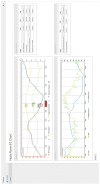A Wearable Wireless Sensor Network for Indoor Smart Environment Monitoring in Safety Applications
- PMID: 28216556
- PMCID: PMC5335942
- DOI: 10.3390/s17020365
A Wearable Wireless Sensor Network for Indoor Smart Environment Monitoring in Safety Applications
Abstract
This paper presents the implementation of a wearable wireless sensor network aimed at monitoring harmful gases in industrial environments. The proposed solution is based on a customized wearable sensor node using a low-power low-rate wireless personal area network (LR-WPAN) communications protocol, which as a first approach measures CO₂ concentration, and employs different low power strategies for appropriate energy handling which is essential to achieving long battery life. These wearables nodes are connected to a deployed static network and a web-based application allows data storage, remote control and monitoring of the complete network. Therefore, a complete and versatile remote web application with a locally implemented decision-making system is accomplished, which allows early detection of hazardous situations for exposed workers.
Keywords: CO2 smart detection; remote web application; safety applications; wearable sensor node; wearable wireless sensor network (W-WSN).
Conflict of interest statement
The authors declare no conflict of interest.
Figures















References
-
- Lee E.A., Seshia S.A. Introduction to Embedded Systems, A Cyber-Physical Systems Approach. 2nd ed. MIT Press; Cambridge, MA, USA: 2017.
-
- Marwedel P. Embedded System Design. Embedded Systems Foundations of Cyber-Physical Systems. 2nd ed. Springer; Dordrecht, The Netherlands: 2011.
-
- Wang H., Liu J., Han J. RS-CPS: A distributed architecture of robotic surveillance cyber-physical system in the nature environment; Proceedings of the IEEE International Conference on Cyber Technology in Automation, Control, and Intelligent Systems (CYBER); Shenyang, China. 8–12 June 2015; pp. 1287–1292.
-
- Paul S., Parajuli A., Barzegaran M.R., Rahman A. Cyber physical renewable energy microgrid: A novel approach to make the power system reliable, resilient and secure; Proceedings of the IEEE Innovative Smart Grid Technologies-Asia (ISGT-Asia); Melbourne, Australia. 28 November–1 December 2016; pp. 659–664.
-
- Wu W., Aziz M.K., Huang H., Yu H., Gooi H.B. A real-time cyber-physical energy management system for smart houses; Proceedings of the IEEE PES Innovative Smart Grid Technologies; Perth, WA, USA. 13–16 November 2011; pp. 1–8.
LinkOut - more resources
Full Text Sources
Other Literature Sources

